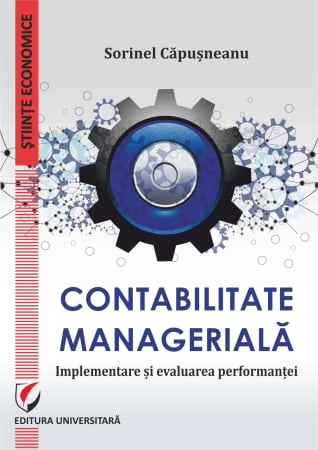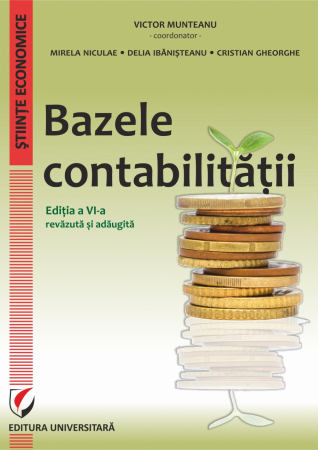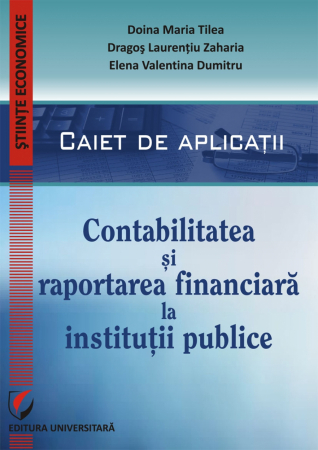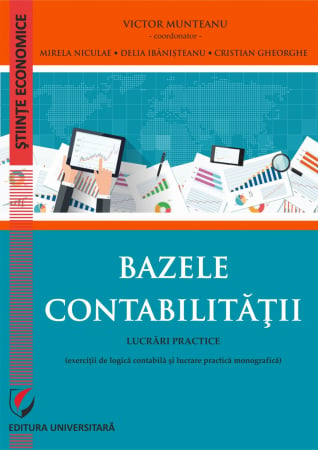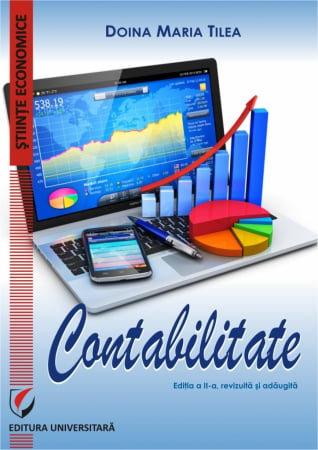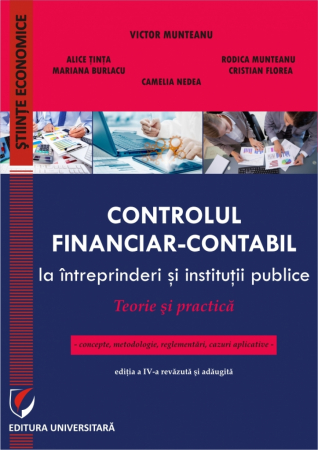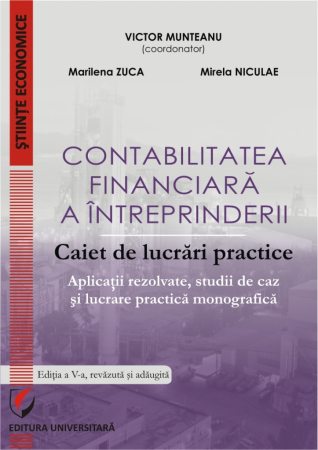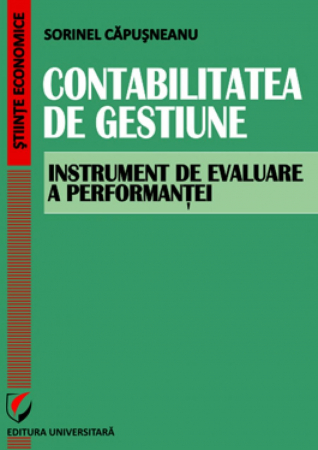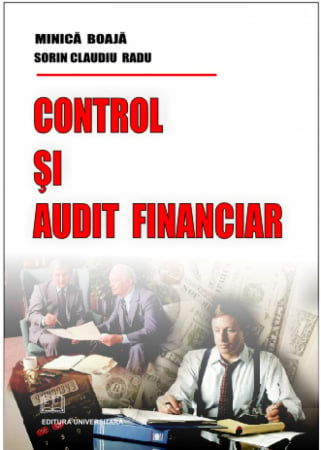6359.png) Accounting. From Theory to Practice. Accounting cycle and closing of the financial exercise, Accounting. From Theory to Practice. Method and ModelingIVth edition, added and revised
Accounting. From Theory to Practice. Accounting cycle and closing of the financial exercise, Accounting. From Theory to Practice. Method and ModelingIVth edition, added and revised
6359.png)
ISBN: 978-606-28-0862-4, 978-606-28-0861-7
DOI: 10.5682/9786062808624, 10.5682/9786062808617
Publisher year: 2019
Edition: IV, revizuita si adaugita
Pages: 330, 328
Publisher: Editura Universitară
Author: Traian-Ovidiu Calota
- Description
- Download (2)
- Content
- Authors
- Reviews (0)
The work “Accounting. From theory to practice. The accounting cycle and the closing of the financial year” aims to complete the area described in“ Accounting. From theory to practice. Method and modeling ”by detailing in a form accessible to beginners, but also useful to practitioners, the main aspects related to the analysis and operation of accounts, the accounting cycle, the closing works of the year, and the interconnection with taxation (VAT mechanism, profit taxation and income of micro-enterprises, taxation of dividends, etc.). The paper ends with an accounting monograph that is an important tool for users to master specific accounting techniques.
In this volume we continued the application of the method of systematization, algorithmization and presentation, in schematic form, of the complex issue, thus achieving not only a condensation of the content but especially the efficiency of understanding and implicitly of learning.
The presented arguments recommend this paper to all those who want to study accounting in the broader context of economic training but also to those who need some details necessary to deepen knowledge and improve practice in the field.
An important element of originality is the interactive nature of practical applications, in the sense that the reader is invited to complete some parts of the analysis and accounting formula with concrete data found in the statement of the problem. Based on the direct observations but also on the pertinent suggestions made by my students, the 4th edition brings substantial changes regarding the introduction of communication exercises, a complex study related to the taxation of incomes obtained by micro-enterprises, as well as the improvement of the accounting monograph.
All this we hope to inscribe the work “Accounting. From theory to practice. The accounting cycle and the closing of the financial year ”in the general efforts of the specialists in the field, in order to provide users with learning and working tools as efficient as possible.
The Author
_________________________________________________________________________________________________________________________________________________________________________________________________________________________________________________________________
The 4th edition of the specialized book “Accounting. From theory to practice. Method and modeling”, which addresses all those who want to acquire and / or deepen their knowledge in the field of accounting, has been improved by updating with the latest changes in accounting legislation, by approaching from a new perspective the main concepts and the inclusion of more suggestive practical examples. To this end, in addition to the detailed presentation of the main theoretical aspects, great emphasis was placed on the schematic synthesis of notions that present complex structures and relationships, as well as on algorithmization and, finally, the representation, in the form of logical schemes, of specific accounting processes. These aspects that personalize the paper are complemented by the harmonious combination of theoretical knowledge with practical examples solved, but also with examples addressed to the reader to be solved and thus ensure a substantial increase in the effectiveness of the learning process.
Therefore, it can be said that, by detailing in the ways described above the accounting issue, starting with its role and place in the organization and management of economic activities, working method, highlighting and reporting the status of an economic entity, this new edition is -an important tool, available to all those interested in learning and specializing in this field. At the same time, the book is accessible and useful to managers at all hierarchical levels as it provides them with the theoretical and practical basis necessary for the efficient organization and management of economic activities.
Last but not least, in the book were inserted a series of important aspects that contribute to highlighting the scientific character of accounting, as well as to creating premises for further improvement of accounting as an information system and, implicitly, as a science. In this sense, the general issue of economic theories and mechanisms was approached, but also the one regarding the establishment and organization of companies, the relationship within them, the relationship between accounting and taxation and management, as well as the impact of managerial decisions on the result.
Finally, we appreciate that this new edition offers the reader an overview of the major role of accounting in initiating and conducting economic and financial transactions.
The Author
INTRODUCERE/ 9
MULTUMIRI / 10
CAPITOLUL 1. ANALIZA SI FUNCTIONAREA CONTURILOR /11
1.1. Conturi de capitaluri/ 11
1.1.1. Schema de analiza si functionare / 12
1.1.2. Exemplificare/ 13
1.1.3. Exercitii de comunicare / 19
1.2. Conturi de imobilizari /24
1.2.1. Schema de analiza si functionare / 24
1.2.2. Exemplificare / 26
1.2.3. Exercitii de comunicare / 35
1.3. Conturi de stocuri, datorii si creante comerciale/ 42
1.3.1. Analiza conturilor de TVA, datorii si creante comerciale/ 43
1.3.2. Studiu de caz pentru neplatitorii de TVA/ 45
1.3.3. Mecanismul TVA in sistem clasic /54
1.3.4. Contabilitatea TVA / 58
1.3.5. Studiu de caz pentru platitorii de TVA clasic (la facturare)/ 63
1.3.6. Studiu de caz pentru platitorii de TVA la incasare/ 69
1.3.7. Studiu de caz complex/ 77
1.3.7.1. Varianta 1: TVA in regim normal (TVA la facturare)/78
1.3.7.2. Varianta 2: Societatea este platitoare de TVA la incasare / 81
1.3.7.3. Varianta 3: Societatea practica TVA la facturare iar partenerii aplica TVA la incasare /84
1.3.8. Exercitii de comunicare/ 87
1.4. Alte conturi de terti si datorii/ 92
1.4.1. Conturi de datorii salariale si sociale / 92
1.4.1.1. Schema de analiza si functionare / 93
1.4.1.2. Exemplificare / 96
1.4.1.3. Exercitii de comunicare / 102
1.4.2. Conturi de debitori si creditori diversi /105
1.4.2.1. Schema de analiza si functionare / 105
1.4.2.2. Exemplificare/ 106
1.5. Conturi de trezorerie/ 109
1.5.1. Schema de analiza si functionare / 110
1.5.2. Exemplificare / 111
1.5.3. Exercitii de comunicare /116
1.6. Conturi de cheltuieli /120
1.7. Conturi de venituri/ 121
1.7.1. Studiu de caz platitor impozit pe profit/ 123
1.7.1.1. Calculul impozitului pe profit /123
1.7.1.2. Operatiuni legate de repartizarea profitului / 137
1.7.2. Studiu de caz platitor impozit pe venitul microintreprinderilor/ 139
1.7.2.1. Metodologia de determinare a impozitului / 140
1.7.2.2. Studiu de caz /
1.7.3. Exercitii propuse spre rezolvare / 164
1.8. Conturi speciale/ 167
1.9. Conturi de gestiune/ 168
CAPITOLUL 2. CICLUL CONTABIL/ 169
2.1. Precizari legale privind organizarea contabilitatii /169
2.2. Ciclul de exploatare/170
2.3. Documentele financiar-contabile /173
2.4. Forme de inregistrare pentru contribuabilii care conduc contabilitatea in partida dubla/ 174
CAPITOLUL 3. INCHIDEREA EXERCITIULUI FINANCIAR / 180
3.1. Inventarierea patrimoniului / 182
3.1.1. Considerente generale / 182
3.1.2. Activitatile pre si post inventariere/183
3.1.3. Succesiunea activitatilor de inventariere /183
3.1.4. Metodologia de inventariere /184
3.1.5. Evaluarea activelor si datoriilor inventariate/189
3.1.6. Studiu de caz privind actualizarea creantelor, datoriilor si disponibilitatilor in valuta /191
3.1.7. Studiu de caz privind constituirea si reluarea ajustarilor pentru deprecierea creantelor/ 197
3.1.8 Studiu de caz privind constituirea si reluarea provizioanelor pentru riscuri viitoare /200
3.2. Intocmirea si prezentarea bilantului contabil / 202
3.3. Intocmirea si prezentarea contului de rezultate /
CAPITOLUL 4. MONOGRAFIE CONTABILA/ 211
4.1. Prezentarea tranzactiilor si evenimentelor din anul infiintarii / 211
4.2. Prezentarea si inregistrarea documentelor contabile / 216
4.3. Prezentarea registrului jurnal / 247
4.4. Prezentarea spre completare a fisei conturilor / 249
4.5. Intocmirea balantei de verificare/ 254
4.6. Anexe monografie / 256
4.6.1. Jurnalele de vânzari si cumparari /256
4.6.2. Declaratii fiscale /257
4.6.2.1. Declaratia 100 / 257
4.6.2.2. Declaratia 112 / 258
4.6.2.3. Decontul 300 TVA /271
4.6.2.4. Declaratia informativa 394 TVA / 276
4.7. Inventariere/ 283
4.7.1. Decizia de inventariere/ 283
4.7.2. Declaratii gestionari /284
4.7.3. Lista de inventariere imobilizari corporale/ 286
4.7.4. Extras de cont / 287
4.7.5. Proces verbal de inventariere /288
4.8. Situatii financiare anuale/ 294
4.8.1. Bilantul prescurtat / 294
4.8.2. Contul prescurtat de profit si pierdere /297
4.8.3. Notele explicative la situatiile financiare anuale / 298
4.9. Prezentarea tranzactiilor si evenimentelor din prima luna a anului urmator / 308
BIBLIOGRAFIE/ 314
LISTA FIGURILOR /317
Anexa 1. PLANUL DE CONTURI GENERAL CONFORM OMFP
1802/2014 / 318
Graduated from the Academy of Economic Studies, Faculty of Accounting and Management, specialization Financial Ratios Enterprise Management Task Force (FATF), postgraduate and master in auditing and accounting management, Ph.D. in Economics at ASE Bucharest.
Teacher Titu University, Faculty of Economics in 1999.
Chartered Accountant, Member CECCAR 2003 and fiscal consultant, member CCRF in 2007.
Financial Director of the company tax consultancy Omega Consulting & Management.

![Accounting. From Theory to Practice. Accounting cycle and closing of the financial exercise, Accounting. From Theory to Practice. Method and ModelingIVth edition, added and revised [1] Accounting. From Theory to Practice. Accounting cycle and closing of the financial exercise, Accounting. From Theory to Practice. Method and ModelingIVth edition, added and revised [1]](https://gomagcdn.ro/domains/editurauniversitara.ro/files/product/large/accounting-from-theory-to-practice-accounting-cycle-and-closing-of-the-financial-exercise-ivth-edition-added-and-revised-184-4978.png)
